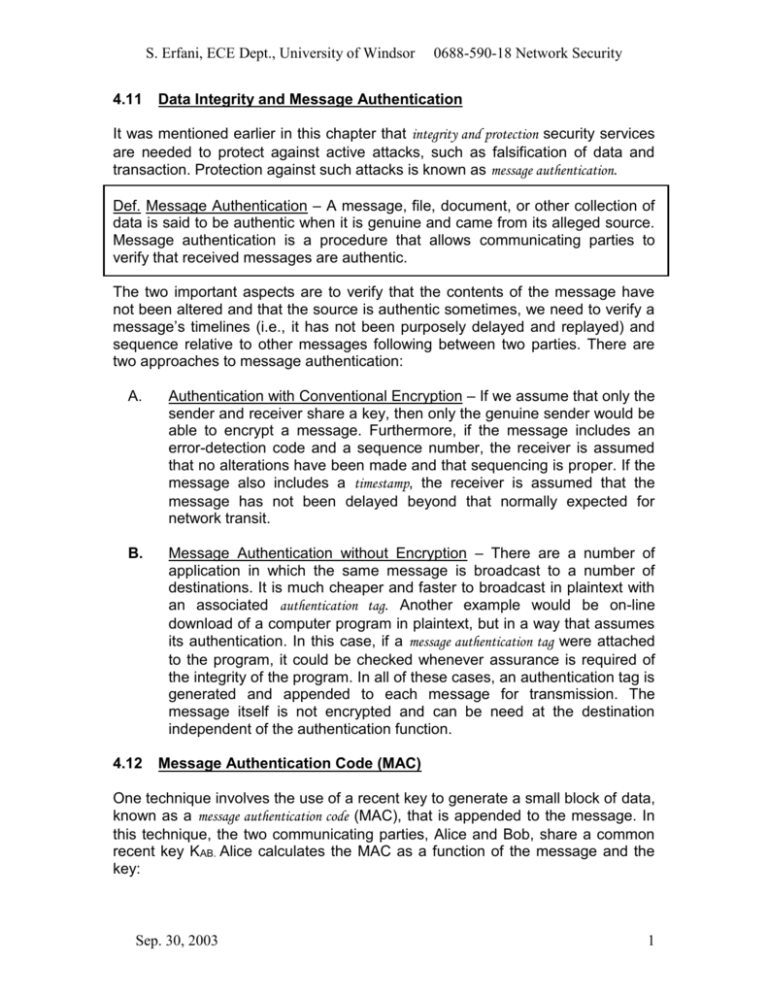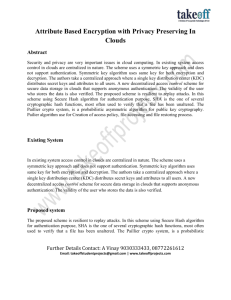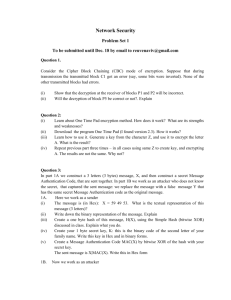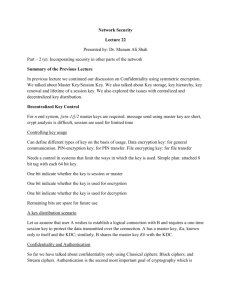Message Authentication
advertisement

S. Erfani, ECE Dept., University of Windsor 4.11 0688-590-18 Network Security Data Integrity and Message Authentication It was mentioned earlier in this chapter that integrity and protection security services are needed to protect against active attacks, such as falsification of data and transaction. Protection against such attacks is known as message authentication. Def. Message Authentication – A message, file, document, or other collection of data is said to be authentic when it is genuine and came from its alleged source. Message authentication is a procedure that allows communicating parties to verify that received messages are authentic. The two important aspects are to verify that the contents of the message have not been altered and that the source is authentic sometimes, we need to verify a message’s timelines (i.e., it has not been purposely delayed and replayed) and sequence relative to other messages following between two parties. There are two approaches to message authentication: A. Authentication with Conventional Encryption – If we assume that only the sender and receiver share a key, then only the genuine sender would be able to encrypt a message. Furthermore, if the message includes an error-detection code and a sequence number, the receiver is assumed that no alterations have been made and that sequencing is proper. If the message also includes a timestamp, the receiver is assumed that the message has not been delayed beyond that normally expected for network transit. B. Message Authentication without Encryption – There are a number of application in which the same message is broadcast to a number of destinations. It is much cheaper and faster to broadcast in plaintext with an associated authentication tag. Another example would be on-line download of a computer program in plaintext, but in a way that assumes its authentication. In this case, if a message authentication tag were attached to the program, it could be checked whenever assurance is required of the integrity of the program. In all of these cases, an authentication tag is generated and appended to each message for transmission. The message itself is not encrypted and can be need at the destination independent of the authentication function. 4.12 Message Authentication Code (MAC) One technique involves the use of a recent key to generate a small block of data, known as a message authentication code (MAC), that is appended to the message. In this technique, the two communicating parties, Alice and Bob, share a common recent key KAB. Alice calculates the MAC as a function of the message and the key: Sep. 30, 2003 1 S. Erfani, ECE Dept., University of Windsor 0688-590-18 Network Security MACM=f(KAB,M) The message plus this MAC code are transmitted to the intended recipient. The recipient performs the same calculation on the received message, using the same recent key, to generate a new MAC code. The received MAC code is compared to the calculated code. If they match, then a) The receiver is assured that the message has not been altered. b) The receiver is assureds that the message is from the alleged sender. c) if the message includes a sequence number, then the receiver can be assured of the proper sequence. This is shown in Figure 5. Message K MAC algorithm Transmit K MAC algorithm Compare MAC K Figure 5 Message Authentication Using a Message Authentication Code(MAC) Sep. 30, 2003 2 S. Erfani, ECE Dept., University of Windsor 0688-590-18 Network Security Note 1 – A number of algorithms could be used to generate the MAC code. The NIST, in its publication entitled DES Modes of Operation, recommends the use of Data Encryption Algorithms (DEA). This algorithms is used to generate an encrypted version of the message, and only the last number of lists of ciphertext are used as the MAC code. A 16-bit or 32-bit code is typical. Note 2 – The process just described is similar to encryption. One difference is that the authentication algorithms need not be reversible, as it must for decryption. Note 3 – The message authentication code is also known as data authentication code (DAC). 4.13 One-Way Hash Function A variation on the MAC code is the one-way hash function. A one-way hash function has many names: compression function, contraction function, message digest, fingerprint, cryptographic checksum, message integrity check (MIC), and modification detection code (MDC). It is central to modern cryptography. As with the message authentication code, a hash function accepts a variable -size message M as input and produces a fixed-size message digest H(M) as output. Unlike the MAC, a hash function does not need a secret key as input. In other words, the one-way hash function is a non-key message digest. To authenticate the message, the message digest is sent with the message in such a way that the message digest is authentic. Note 4 – A simple hash function would be a function that takes the input message and returns some bytes consisting of the XOR of all the input bytes. Figure 6 shows the 3 ways in which a message can be authenticated: Message Message Message H Compare H K K E D Sep. 30, 2003 3 S. Erfani, ECE Dept., University of Windsor 0688-590-18 Network Security (a) Using conventional encryption Message Message Message H Compare H Kprivate Kpublic E D (b) Using conventional encryption Message Message Message H Compare H (c) Using secret value Figure 6 Message Authentication Using a One-Way Function (a) A message digest can be encrypted using conventional encryption. (b) The message also can be encrypted using public-key encryption (to be discussed in the next chapter). This has two advantages: (1) it provides Sep. 30, 2003 4 S. Erfani, ECE Dept., University of Windsor 0688-590-18 Network Security a digital signature (to be discussed later), (2) it does not require the distribution of keys to communicating parties. (c) We can use a hash function but no encryption for message authentication, as shown in Fig.6(c). this technique assumes that two communicating parties, Alice and Bob, share a common secret value S AB When Alice has a message to send to Bob, she calculates the hash function over the concatenation of the secret value and the message as: MDM=H(SAB||M) Where || denotes concatenation. Alice then sends [M||MDM] to Bob. Because Bob possesses SAB, he can recomputed H(SAB||M) and verify MDM . Because the secret value itself is not sent, it is not possible for an opponent, Oscar, to modify an intercepted message. As long as the secret value SAB remains secret, it is not possible for an opponent to generate a false message. Note 5 – A variation of the above technique called HMAC, is adopted for IP security protocol. This is a strong collision resistance property. Def. – Hash Function – A hash family is a four-tuple (X, Y, K, H), where the following conditions are satisfied: 1) X is a set of possible messages. 2) Y is a finite set of possible message digests or authentication tags. 3) K, the key space, is a finite set of possible keys. 4) For each kK, there exists a hash function hk H, such that for each hk: X →Y. Note 6 – The hash function takes a variable-length input string, called a pre-image, and produces a fixed-length (generally smaller) output string, called a hash value. Note 7 – To be useful for message authentication, a hash function H must have the following properties: 1) H can be applied to any size of data. 2) H must produces a fixed-length output. Sep. 30, 2003 5 S. Erfani, ECE Dept., University of Windsor 0688-590-18 Network Security 3) H(x) should be relatively easy to compute for any given x, making both hardware and software implementation practical. 4) For any given code h, it should be computationally infeasible to find x such that H(x)=h. this is the “one-way” property. 5) For any given block x, it should be computationally infeasible to find xy with H(y)=H(x). This property is called a weak collision resistance. 6) It should be computationally infeasible to find any pair (x,y) such that H(x)=H(y). Note 8 – The fourth property listed above is the “one-way” property. That is , it should be virtually impossible to generate a message given a hash value code. Note 9 – A hash function that satisfies the first five properties in the preceding list is referred to as a weak hash function. If the sixth property is also satisfied, then it is referred to as a strong hash function. The sixth property protects against a sophisticated class of attack known as the birthday attach. Note 10 – in addition to providing authentication, a message digest also provides data integrity. If performs the same function as a frame check sequence. Sep. 30, 2003 6








